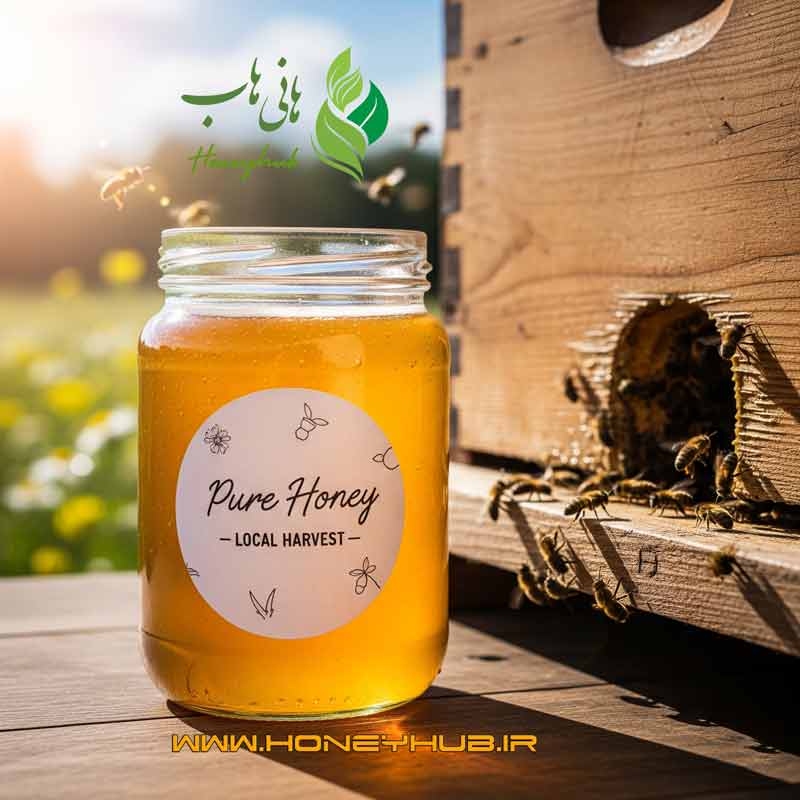Does your mozzarella refuse to stretch or just burn? The secret is science. From "pasta filata" to the crucial role...
The Ultimate Guide to the Nutritional Value & Health Benefits of Honey (Science-Backed)
The Nutritional Value of Honey: A Comprehensive Scientific Analysis, Therapeutic Properties, and a Complete Guide to Consumption
Honey, this ancient food whose use dates back thousands of years, has always held a special place in the diet and traditional medicine of various nations. From Stone Age carvings depicting honey harvesting to Egyptian papyrus scrolls recording over 500 therapeutic recipes with honey, this liquid gold has always been known as a symbol of sweetness, energy, and healing [1]. But beyond traditional beliefs, what is the perspective of modern science today regarding the nutritional value and therapeutic properties of honey? In this article, citing the latest scientific research, we will dissect the chemical composition of honey, examine its amazing properties, and provide a comprehensive guide for its intelligent consumption.

Honey, a sweet and nutritious gift from nature whose properties are also confirmed by modern science.
Chemical Analysis of Honey: What Is Hidden in a Spoonful of Honey?
Honey is a supersaturated solution of sugars, but its value extends far beyond its sweetness. In general, honey is composed of about 200 different substances! [2]. These compounds vary depending on the plant source, geographical region, and climatic conditions, but its main structure includes the following:
1. Carbohydrates (Sugars): The Main Source of Energy
About 80 to 85 percent of the dry weight of honey is composed of carbohydrates. Unlike white sugar (sucrose), the sugars in honey are mainly monosaccharides:
- Fructose (Fruit Sugar): About 38% - This is the sweetest natural sugar and is absorbed slowly, which contributes to honey's lower Glycemic Index (GI) compared to sugar.
- Glucose: About 31% - This sugar is quickly absorbed by the body and is a source of immediate energy.
This dual combination of slow- and fast-absorbing sugars makes honey a unique energy source that can provide sustained and long-lasting energy [3]. In addition, about 1-5% of the sugars are disaccharides (like sucrose and maltose) and oligosaccharides. These oligosaccharides act as prebiotics, helping to nourish beneficial gut bacteria [4].
2. Water: The Stability Factor
The water content in honey varies between 13 and 20 percent. This low moisture content, along with high acidity, is one of the main reasons for honey's long shelf life and its resistance to microbial spoilage. Honey with a moisture content below 18% is of higher quality and has a very low probability of fermentation.
3. Minor but Powerful Compounds (about 3-5%)
This small portion is primarily responsible for the biological and therapeutic properties of honey:
- Organic Acids: The predominant acid in honey is "gluconic acid," produced by the enzyme glucose oxidase. These acids give honey its acidic pH (between 3.2 and 4.5), which inhibits the growth of many bacteria [2].
- Enzymes: Honey contains important enzymes secreted from the glands of honeybees. The most important ones are:
- Diastase (Amylase): Breaks down starch and is an indicator of honey's quality and freshness.
- Invertase (Sucrase): Converts the sucrose from nectar into fructose and glucose.
- Glucose Oxidase: Oxidizes glucose to produce "hydrogen peroxide," which is one of the main factors behind honey's antibacterial properties [5].
- Minerals and Vitamins: Honey contains small amounts of minerals such as potassium, calcium, magnesium, iron, zinc, and selenium. It also contains B-group vitamins and vitamin C. Although these amounts are not sufficient to meet daily needs, they add to its overall nutritional value. Darker honeys generally have more minerals [3].
- Phenolic Compounds and Flavonoids: These are the most important antioxidants found in honey. Compounds like pinocembrin, chrysin, galangin, and caffeic acid are responsible for honey's ability to combat oxidative stress and inflammation in the body. The plant source is the main determinant of the type and amount of these compounds [6].
The true power of honey lies not in its sugars, but in the synergy of its minor components. Its low acidity, high osmotic pressure (due to sugar concentration), hydrogen peroxide production, and the presence of phenolic compounds together create a powerful defensive barrier against microbes and shape its therapeutic properties [1].
Difference in Source: Why is Every Honey Unique?
As mentioned, the chemical profile of honey is highly dependent on its plant source. "Monofloral" honey is produced from the nectar of a dominant plant (like thyme, sidr, or astragalus), while "Polyfloral" honey is produced from the nectar of various flowers.
Another important distinction is between Blossom Honey and Honeydew Honey. Honeydew honey is made from the sweet secretions of insects on trees (like pine and oak). Research has shown that due to its darker color, honeydew honey typically has a higher concentration of minerals (especially potassium) and antioxidant compounds, as well as higher electrical conductivity [7]. This type of honey is very popular in Europe and has its own fans due to its strong flavor and lower sweetness.

The plant source is the key to the difference in taste, color, aroma, and therapeutic properties of various types of honey.
Therapeutic Properties and Health Benefits of Honey (Based on Scientific Evidence)
1. Antimicrobial Activity and Wound Healing
This is one of honey's most well-documented properties. The antimicrobial mechanisms of honey are manifold: acidic pH, osmotic effect (which draws water out of bacterial cells), production of hydrogen peroxide, and the presence of non-peroxide compounds like flavonoids and methylglyoxal (MGO) [5]. Manuka honey, produced from the nectar of the Manuka tree in New Zealand, has exceptionally strong antibacterial properties due to its very high level of MGO and has even been effective against antibiotic-resistant bacteria like MRSA [8]. Topical application of medical-grade honey can help cleanse wounds, reduce inflammation, and stimulate new tissue growth.
2. A Powerful Natural Antioxidant
Free radicals are unstable molecules that damage cells and play a role in the aging process and chronic diseases like heart disease and cancer. Antioxidants neutralize these molecules. Honey, especially darker varieties like buckwheat, avocado, and honeydew honey, is rich in phenolic compounds that have high antioxidant capacity. Studies have shown that regular consumption of honey can increase the level of antioxidants in the blood and help protect the body against oxidative stress [6], [9].
3. Digestive Health and Prebiotic Effects
As mentioned, the oligosaccharides in honey act as prebiotics. They reach the large intestine undigested and serve as food for beneficial bacteria like Bifidobacterium and Lactobacillus. This helps improve the balance of the gut microbiome, strengthen the immune system, and enhance digestion and nutrient absorption [4]. Additionally, some studies have shown that honey may be useful in treating gastritis and peptic ulcers caused by the bacterium Helicobacter pylori.
4. Cough Relief and Improvement of Cold Symptoms
The World Health Organization (WHO) recognizes honey as a potential treatment for coughs and sore throats. Several clinical trials have shown that consuming a small amount of honey (about 2.5 to 10 ml) before bed can reduce the severity and frequency of coughing in children more effectively than some common cough medicines, improving their and their parents' quality of sleep [10]. The coating and anti-inflammatory properties of honey help soothe an irritated throat.
5. Cardiovascular Health
Emerging research suggests that honey may have positive effects on heart health. The antioxidant compounds in honey can help reduce blood pressure, improve blood fat levels (lowering bad LDL cholesterol and triglycerides while raising good HDL cholesterol), and prevent the oxidation of LDL cholesterol (a key step in atherosclerosis) [11]. However, more human research is needed for definitive conclusions in this area.
6. Honey in Diabetes Management: A Double-Edged Sword
This is a very sensitive topic that requires caution. Honey is still a source of sugar and raises blood sugar. However, studies have shown that honey's glycemic index (GI) is lower than that of sucrose (white sugar) and dextrose. Some research suggests that compared to sugar, honey may cause a smaller increase in blood sugar levels and can even increase C-peptide levels, indicating better insulin production [12]. This does not mean that people with diabetes can consume honey freely. Rather, in very small and controlled amounts, it might be a better alternative to sugar. Consulting with a doctor or nutritionist is absolutely essential for individuals with diabetes before consuming honey.
Correct Amount and Method of Consumption
Despite all its benefits, honey is still a food rich in sugar and should be consumed in moderation.
- Daily Consumption Amount: For a healthy adult, consuming one to two tablespoons (about 20 to 40 grams) of honey daily is sufficient and beneficial. Athletes can consume more as a natural energy source depending on the intensity of their activity.
- Best Method of Consumption: To preserve the maximum enzymatic and therapeutic properties of honey, it is best not to add it to hot drinks or foods (above 40°C or 104°F), as high heat can destroy its beneficial enzymes. The best method is to dissolve it in lukewarm water or milk, or add it to yogurt, smoothies, and salads.
- Infant Botulism: Never give honey to children under one year of age. Their digestive systems are not yet fully developed, and there is a risk of infant botulism (a rare but serious illness caused by the spores of the Clostridium botulinum bacterium) [1].
- Allergies: People with severe allergies to pollen may also react to honey, as it contains small amounts of pollen.
- Contaminants: The quality of honey depends on the health of the environment where it is produced. In polluted areas, honey may contain heavy metals or pesticides. Therefore, buying from reputable sources and committed beekeepers is very important.
Conclusion
Scientific reviews confirm that the nutritional value of honey extends far beyond its sweet taste. This natural substance is a complex matrix of energizing sugars, powerful antioxidants, active enzymes, and antimicrobial compounds that can help boost the immune system, improve digestive health, protect the heart, and relieve cold symptoms. However, honey is not a magic bullet and should be consumed as part of a balanced and healthy diet, in moderation. By choosing high-quality honey from reputable sources and consuming it intelligently, you can benefit from this wonderful gift of nature to enhance your health and well-being.
Leave a comment
Log in to post comments
Related posts
 Why does pollen improve your health?
Why does pollen improve your health? 10 Ways to Consume Bee Pollen
10 Ways to Consume Bee Pollen



















Latest comments